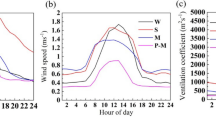Abstract
There is a need to recognize air pollution levels by particles, especially in developing countries such as Jordan where data are scarce due to the absence of routine monitoring of ambient air quality. This study aims at studying the air quality in different locations at Irbid, Jordan through the measurement and analysis of the time series of black carbon light absorption coefficients (B abs). Black carbon light absorption coefficients were measured with a photoacoustic instrument at a wavelength of 870 nm. The measurements were conducted during July 2007 at six sites in Irbid city, Jordan. Comparisons of black carbon concentrations at various locations were conducted to understand where values tend to be largest. The average value of B abs of all sites was 40.4 Mm − 1. The largest value of B abs was 61.2 Mm − 1 at Palestine Street which is located at a very crowded street in a highly populated region in the city center. The lowest value was 14.1 Mm − 1 at Thirtieth Street which is located at a main street in an open plain region in the east of the city. The black carbon light absorption coefficients fluctuate above a background level (transported black carbon from the neighboring states), which are almost identical at all sampling sites. The light absorption coefficients will be used as a benchmark in later years as combustion efficiencies and population patterns change.
Similar content being viewed by others
References
Arnott, W. P., Moosmuller, H., Rogers, C. F., Jin, T., & Bruch, R. (1999). Photoacoustic spectrometer for measuring light absorption by aerosol: Instrument description. Atmospheric Environment, 33, 2845–2852. doi:10.1016/S1352-2310(98)00361-6.
Arnott, W. P., Hamasha, K., Moosmüller, H., Sheridan, P. J., & Ogren, J. A. (2005). Towards aerosol light absorption measurements with a 7-wavelength aethalometer: Evaluation with a photoacoustic instrument and a 3 wavelength nephelometer. Aerosol Science and Technology, 39, 17–29. doi:10.1080/027868290901972.
Arrhenius, S. (1896). On the influence of carbonic acid in the air upon the temperature of the ground. Philosophical Magazine, 41, 237–276.
Eidels-Dubovoi, S. (2002). Aerosol impacts on visible light extinction in the atmosphere of Mexico City. The Science of the Total Environment, 287, 213–220.
Finlayson-Pitts, B. J., & Pitts, J. N. J. (2000). Chemistry of the upper and lower atmosphere: Theory, experiments and applications. London: Academic.
Gardiner, K., van Tongeren, M., & Harrington, M. (2001). Respiratory health effects from exposure to carbon black: Results of the phase 2 and 3 cross sectional studies in the European carbon black manufacturing industry. Occupational and Environmental Medicine, 58(8), 496–503. doi:10.1136/oem.58.8.496.
Gillmour, P. S., Ziesenis, A., Morrison, E. R., Vickers, M. A., Drost, E. M., Ford, I., et al. (2004). Pulmonary and systematic effects of short-term inhalation exposure to ultrafine carbon black particles. Toxicology and Applied Pharmacology, 195(1), 35–44. doi:10.1016/j.taap.2003.10.003.
Greater Irbid Municipality. Retrieved 16 June 2008 from http://www.Irbid.gov.jo.
Groblicki, P. J., Wolff, G. T., & Countess, R. J. (1981). Visibility reducing species in the Denver brown cloud I. Atmospheric Environment, 15, 2473–2484. doi:10.1016/0004-6981(81)90063-9.
Horvath, H. (1995). Size segregated light absorption coefficient of the atmospheric aerosol. Atmospheric Environment, 29, 875–883. doi:10.1016/1352-2310(95)00025-T.
IPCC (Intergovernmental Panel on Climate Change). (1996). Climate change 1995: The science of climate change. Contribution of Working Group I to the Second Assessment Report (edited by Houghton, J. T., Meira Filho, L. G., Callender, B. A., Harris, N., Kattenberg, A., & Maskell, K.). Cambridge University Press, Cambridge, UK.
Kirchstetter, T. W., Novakov, T., & Hobbs, P. V. (2004). Evidence that the spectral dependence of light absorption by aerosols is affected by organic carbon. Journal of Geophysical Research, 109(D21), D21208. doi:10.1029/2004JD004999.
Liu, L., & Smith, M. H. (1995). Urban and rural aerosol particle optical properties. Atmospheric Environment, 29, 3293–3301. doi:10.1016/1352-2310(95)00236-R.
Parent, M. E., Siemiatycki, J., & Fritschi, L. (2000). Workplace exposures and oesophageal cancer. Occupational & Environmental Medicine, 57, 325–334.
Pratsinis, S., Novakov, T., Ellis, E. C., & Friedlander, S. K. (1984). The carbon containing component of the Los Anglos aerosol: Source, apportionment, and contributions to the visibility budget. Air Pollution Control Association, 34, 643–650.
Author information
Authors and Affiliations
Corresponding author
Rights and permissions
About this article
Cite this article
Hamasha, K.M., Arnott, W.P. Photoacoustic measurements of black carbon light absorption coefficients in Irbid city, Jordan. Environ Monit Assess 166, 485–494 (2010). https://doi.org/10.1007/s10661-009-1017-3
Received:
Accepted:
Published:
Issue Date:
DOI: https://doi.org/10.1007/s10661-009-1017-3




